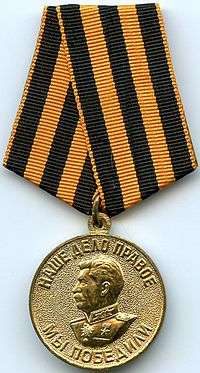Russian Air Force
| Russian Air Force Военно-воздушные cилы России Voyenno-vozdushnye sily Rossii | |
|---|---|
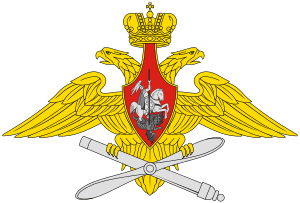 Russian Air Force emblem | |
| Founded | 7 May 1992 |
| Country |
|
| Branch |
|
| Type | Air force |
| Size | 148,000 personnel (2018) + 3,200 aircraft [1] |
| Headquarters | Moscow, Russia |
| March | "Air March" (Russian: "Авиамарш")[2][3][4] |
| Anniversaries | 12 August |
| Engagements |
First Chechen War War of Dagestan Second Chechen War Russo-Georgian War Syrian Civil War[5] |
| Commanders | |
| Current commander | Lieutenant General Andrey Yudin |
| Insignia | |
| Flag |
 |
| Roundel |
 |
| Aircraft flown | |
| Attack | Su-24, Su-25, Su-34, Tu-22M, Tu-95, Tu-160 |
| Fighter | MiG-29, MiG-35, Su-27, Su-30, Su-35, Su-57 |
| Helicopter | Mi-8, Mi-17, Mi-26, Ka-60 |
| Attack helicopter | Mi-24, Mi-28, Ka-50, Ka-52 |
| Interceptor | MiG-31 |
| Trainer | Yak-130 |
| Transport | Il-76, Il-112, An-26, An-124, An-140, An-148 |
The Russian Air Force (Russian: Военно-воздушные cилы России, tr. Voyenno-Vozdushnye Sily Rossii, literally "military air forces of Russia") is a branch of the Russian Aerospace Forces, the latter being formed on 1 August 2015 with the merger of the Russian Air Force and the Russian Aerospace Defence Forces.[6] The modern Russian Air Force was originally established on 7 May 1992 following Boris Yeltsin's creation of the Ministry of Defence; however the Russian Federation's air force can trace its lineage and traditions back to the Imperial Russian Air Service (1912–1917) and the Soviet Air Forces (1918–1991).
The Russian Navy has its own independent air arm, the Russian Naval Aviation, which is the former Soviet Aviatsiya Voyenno-morskogo Flota (lit. "Aviation of the military-sea fleet"), or AV-MF.
History
| Air Forces of Russia |
|---|
|
Air Force (1909–1917) Red Air Force (1918–1991) Naval Aviation (1918–1991) Air Defence (1948–1991) Strategic Rocket Forces (1959–1991) Air Force (1991–present) Naval Aviation (1991–present) Strategic Rocket Forces (1991–present) |
| Armed Forces of the Russian Federation |
|---|
.svg.png) |
| Services (vid) |
| Independent troops (rod) |
| Other troops |
|
| Ranks of the Russian Military |
| Uniforms of the Russian Military |
| History of the Russian military |
1991–2000
Following the dissolution of the Soviet Union into its fifteen constituent republics in December 1991, the aircraft and personnel of the Soviet Air Forces – the VVS were divided among the newly independent states. General Pyotr Deynekin, the former deputy commander-in-chief of the Soviet Air Forces, became the first commander of the new organisation on 24 August 1991. Russia received the majority of the most modern fighters and 65% of the manpower. The major commands of the former Soviet VVS – the Long Range Aviation, Military Transport Aviation and Frontal Aviation were renamed, with few changes, Russian VVS commands. However, many regiments, aircraft, and personnel were claimed by the republics they were based in, forming the core of the new republics' air forces. Some aircraft in Belarus and Ukraine (such as Tupolev Tu-160s) were returned to Russia, sometimes in return for debt reductions, as well as a long range aviation division based at Dolon in Kazakhstan.
During the 1990s, the financial stringency felt throughout the armed forces made its mark on the Air Forces as well.[7] Pilots and other personnel could sometimes not get their wages for months, and on occasion resorted to desperate measures: four MiG-31 pilots at Yelizovo in the Far East went on hunger strike in 1996 to demand back pay which was several months overdue, and the problem was only resolved by diverting unit money intended for other tasks.[8] As a result of the cutbacks, infrastructure became degraded as well, and in 1998, 40% of military airfields needed repair.
The VVS participated in the First Chechen War (1994–1996) and the Second Chechen War (1999–2002). These campaigns also presented significant difficulties for the VVS including the terrain, lack of significant fixed targets and insurgents armed with Stinger and Strela-2M surface-to-air missiles.
The former Soviet Air Defence Forces remained independent for several years under Russian control, only merging with the Air Forces in 1998. The decree merging the two forces was issued by President Boris Yeltsin on 16 July 1997. During 1998 altogether 580 units and formations were disbanded, 134 reorganized, and over 600 given a new jurisdiction.[9] The redistribution of forces affected 95% of aircraft, 98% of helicopters, 93% of anti-aircraft missile complexes, 95% of the equipment of radiotechnical troops, 100% of anti-aircraft missiles and over 60% of aviation armament. More than 600,000 tons of material changed location and 3500 aircraft changed airfields. Military Transport Aviation planes took more than 40,000 families to new residence areas.
The short-lived operational commands were abolished. Two air armies, 37th Air Army (long-range aviation) and 61st Air Army (former Military Transport Aviation), were established directly under the Supreme Command. The former frontal aviation and anti-aircraft forces were organized as Air Force Armies and Anti-Aircraft Defense Armies under the military district commanders. There were initially four such armies with headquarters in St.Petersburg (Leningrad Military District), Rostov-on-Don (North Caucasus Military District), Khabarovsk (Far East Military District), and Chita (Siberian Military District). Two military districts had separate Air and Air Defence Corps. When the Transbaikal Military District and Siberian Military District were merged, the 14th Air Army was reactivated to serve as the air force formation in the area.
The number of servicemen in the Air Force was reduced to about 185,000 from the former combined number of 318,000. 123,500 positions were abolished, including almost 1000 colonel positions. The resignation of 3000 other servicemen included 46 generals of which 15 were colonel generals. On 29 December 1998 Colonel General Anatoly Kornukov, a former Air Defence Forces officer and new commander-in-chief of the merged force, succeeding Deynekin, reported to the Russian defence minister that the task had 'in principle been achieved'.[10] General Kornukov established the new headquarters of the force in Zarya (ru:Заря (микрорайон Балашихи)), near Balashikha, 20 km east of the centre of Moscow, in the former PVO central command post, where the CIS common air defence system is directed from.
2001–2010
In 1999 Vladimir Putin became prime minister of Russia and then president in 2000; he continued to hold one or the other of these offices through every year since.
In December 2003 the aviation assets of the Russian Ground Forces —mostly helicopters— were transferred to the VVS, following the shooting down of a Mi-26 helicopter in Chechnya on 19 August 2002, that claimed 19 lives. The former Army Aviation was in its previous form intended for the direct support of the Ground Forces, by providing their tactical air support, conducting tactical aerial reconnaissance, transporting airborne troops, providing fire support of their actions, electronic warfare, setting of minefield barriers and other tasks. The former Army Aviation was subsequently managed by the Chief of the Department of Army Aviation.[11] However, by 2010, it was announced that the 2003 decision to transfer Ground Force Aviation to the Air Force was reversed, with the transfer back to the Ground Forces to occur sometime in 2015 or 2016.[12]
During the 2000s, the Air Forces continued to suffer from a lack of resources for pilot training. In the 1990s Russian pilots achieved approximately 10% of the flight hours of the United States Air Force. The 2007 edition of the International Institute for Strategic Studies (IISS) Military Balance listed pilots of tactical aviation flying 20–25 hours a year, 61st Air Army pilots (former Military Transport Aviation), 60 hours a year, and Army Aviation under VVS control 55 hours a year.[13]
In 2007 the Russian Air Force resumed the Soviet-era practice of deploying its strategic bomber aircraft on long-range patrols. This ended a 15-year unilateral suspension due to fuel costs and other economic difficulties after the collapse of the Soviet Union.[14][15] Patrols towards the North Pole, the Atlantic and the Pacific Ocean were reinstated, bringing the planes often close to NATO territory, including in one instance flying over the Irish Sea between the United Kingdom and Ireland.[16]
During the 2008 South Ossetian War, the Russian Air Force suffered losses of between four and seven aircraft due to Georgian anti-aircraft fire. The 2008 Russian military reforms were promptly announced following the war, which according to Western experts were intended to address many inadequacies discovered as a result. The reforms commenced during early 2009, in which air armies were succeeded by commands, and most air regiments becoming airbases.[17] Aviation Week & Space Technology confirmed that the reorganisation would be completed by December 2009 and would see a 40 percent reduction in aircrew numbers.[18]
In February 2009, the Russian newspaper Kommersant reported that 200 of the 291 MiG-29s currently in service across all Russian air arms were unsafe and would have to be permanently grounded.[19] This action would remove from service about a third of Russia's total fighter force, some 650 aircraft. On 5 June 2009, the Chief of the General Staff, Nikolai Makarov said of the Russian Air Force that "They can run bombing missions only in daytime with the sun shining, but they miss their targets anyway".[20] Maj. Gen. Pavel Androsov said that Russia's long-range bombers would be upgraded in 2009 with the aim of being able to hit within 20 meters of their targets.[21]
Also in September 2009 it was reported that an East European network of the Joint CIS Air Defense System was to be set up by Russia and Belarus.[22] This network was intended to protect the airspace of the two countries as defined in the supranational 1999 Union State treaty. Its planned composition was to include five Air Force units, 10 anti-aircraft units, five technical service and support units and one electronic warfare unit. It was to be placed under the command of a Russian or Belarusian Air Force or Air Defence Force senior commander.
In July 2010, Russian jet fighters made the first nonstop flights from European Russia to the Russian Far East.[23] By August 2010, according to the commander-in-chief of the Russian Air Force Aleksandr Zelin (interview to the Ekho Moskvy radio station, 14 August 2010), the average flight hours of a pilot in Russian tactical aviation had reached 80 hours a year, while in army aviation and military transport aviation it exceeded 100 hours a year.[24] On 15 August 2010, the Russian Air Force temporarily grounded its fleet of Su-25 ground attack aircraft to conduct an investigation into a crash that happened during a training mission. The Russian Defence Ministry said that the plane crashed on 6 August 2010, 60 km to the north-west of Step air base in Siberia, according to RIA Novosti.
2011–present
According to the instructions of the General Staff of the Armed Forces on 1 September 2011, the unmanned aircraft of the RuAF and the personnel operating them moved under the command structure of the Russian Ground Forces.[25]
As of 2012, the Russian Air Force operated a total of 61 air bases, including 26 air bases with tactical aircraft, of which 14 are equipped with fighter aircraft. In terms of flight hours, pilots in the Western Military District averaged 125 hours over the 2012 training year. Pilots from the Kursk airbase achieved an average of 150 hours, with transport aviation averaging 170 hours.[26]
On 1 August 2015, the Russian Air Force, along with the Russian Aerospace Defense Forces and the Air Defense Troops, were merged into a new branch of the Armed Forces, now officially called the Russian Aerospace Forces.[6]
On 30 September 2015 the Russian Air Force launched a military intervention in Syria, in Syria's Homs region.[27] On 24 November 2015, during this intervention, the Turkish Air Force shot down a Russian Sukhoi Su-24 that Turkey claimed had entered its airspace.[28][29]
Leadership
.jpg)
Previous highest military office, pre-2015 merger.
| Commander-in-chief of the Russian Air Force | Years |
|---|---|
| General Pyotr Deynekin | (1991–1998) |
| General Anatoly Kornukov | (1998–2002) |
| General Vladimir Mikhaylov | (2002–2007) |
| Colonel General Aleksandr Zelin | (9 May 2007 – 27 April 2012) |
| Colonel General Viktor Bondarev | (2012–2015) |
Since the merger between the Russian Air Force and the Russian Aerospace Defence Forces on 1 August 2015, the commander of the Russian Air Force as part of the new Russian Aerospace Forces is titled Deputy Commander-in-chief of the Russian Aerospace Forces and Commander of the Russian Air Force.[6] Lieutenant General Andrey Yudin became the first holder of the position.[30]
Organisation

In 2009 the Russian Air Forces' structure was completely changed to a command-air base structure from the previous structure of air army-air division or corps-air regiment. The VVS is now divided to 4 operational commands, the Aerospace Defense Operational Strategic Command (seemingly primarily made up of the former Special Purpose Command), the Military Transport Aviation Command, and the Long Range Aviation Command.[32] This listing is a composite; the available new information covers frontline forces, and the forces of central subordination are as of approximately August 2008. Warfare.ru maintains what appears to be a reasonably up to date listing, and Combat Aircraft magazine in June 2010 listed their organisation's estimate of the new order of battle.
This listing appears to be as of June 2009
- 1st Aerospace Defence Forces Army (Moscow)
- 4th Aerospace Defense brigade (Dolgoprudnyi, Moscow Oblast)
- 5th Aerospace Defense brigade (Petrovskoe, Moscow Oblast)
- 6th Aerospace Defense brigade (Rzhev, Tver Oblast) (former 32nd Corps of PVO?)
- 6963rd aviation base (Kursk Vostochny Airport) (MiG-29SMT/UBT)
- 6968th fighter aviation base (Borisovsky Khotilovo, Tver Oblast) (Su-27, MiG-31B, MiG-31BM)
- 6th Air and Air Defence Forces Army (Voronezh) (Western Military District)
- 1st Aerospace Defense brigade (Severomorsk)
- 2nd Aerospace Defense brigade (St. Petersburg)
- 6961st aviation base (Petrozavodsk Airport) (Su-27)
- 6964th aviation base (Monchegorsk Airbase, Murmansk Oblast) (Su-24M, Su-24MR)
- 6965th aviation base (Vyazma Airport, Smolensk Oblast) (Mi-8TM, Mi-24V, Mi-28N)
- 7000th aviation base (Voronezh Malshevo Airbase) (Su-24M, Su-24MR, Su-34)
- 14th Air and Air Defence Forces Army (Yekaterinburg) (Central Military District)
- 8th Aerospace Defense brigade (Yekaterinburg)
- 9th Aerospace Defense brigade (Novosibirsk)
- 10th Aerospace Defense brigade (Chita)
- 6977th Aviation Base (Bolshoye Savino Airport, Perm Krai) (MiG-31BM)
- 6979th aviation base (Kansk Airbase, Krasnoyarsk Krai) (MiG-31BM)
- 6980th aviation base (Chelyabinsk Shagol Airport) (Su-24M)
- 6982nd aviation base (Domna Airbase, Zabaykalsky Krai) (MiG-29, Su-30SM)
- 11th Air and Air Defence Forces Army(Khabarovsk) (Eastern Military District)
- 11th Aerospace Defense brigade (Komsomolsk-na-Amur)
- 12th Aerospace Defense brigade (Vladivostok)
- 6983rd aviation base (Komsomolsk-on-Amur Airport, Khabarovsk Krai) (Su-27SM, Su-30M2, Su-35S, Su-34)
- 6988th aviation base (Khurba, Khabarovsk Krai) (Su-24M, Su-24M2, Su-24MR)
- 6989th aviation base (Vladivostok International Airport) (Su-27SM)
- 265th transport aviation base (Khabarovsk)
- 4th Air and Air Defence Forces Army — Southern Military District (former 4th and 5th Armies of VVS and PVO) (Rostov-on-Don)
- 7th Aerospace Defense brigade (Rostov-on-Don)
- 8th Aerospace Defense brigade (Yekaterinburg)
- 6970th aviation base (Morozovsk, Rostov Oblast) (Su-24M, Su-34)
- 6971st aviation base (Budyonnovsk, Stavropol Krai) (Su-25SM, Mi-8AMTSh, Mi-24V, Mi-28N)
- 6972nd aviation base (Krymsk, Krasnodar Krai) (Su-27, Mi-8, Mi-24P, Mi-28N, Ka-27)
- 6974th aviation base (Korenovsk, Krasnodar Krai) (Mi-8MTV-5, Mi-24V, Mi-35M, Mi-28N)
- 999th aviation base (Kant Air Base, Kyrgyzstan) (Su-25, Su-27, Mi-8T)
- 229th transport aviation base (Rostov-on-Don) (Mi-26(T), Mi-8AMTSh(TM))
- Military Transport Aviation Command (Moscow)
- 6955th Aviation Base (Migalovo (Tver)) (Il-76MD)
- 6956th Aviation Base (Orenburg) (Il-76MD)
- 6958th Aviation Base (Taganrog, Rostov Oblast) (Il-76MD)
- 6985th Aviation Base (Pskov Airport) (Il-76MF)
- Long Range Aviation Command (Moscow)
- 6950th Aviation Base (Engels-2, Saratov Oblast) (Tu-22 M3, Tu-95 MS6, Tu-160) former 22nd Guards Heavy Bomber Aviation Division
- 6952nd Aviation Base (Ukrainka Airbase, Amur Oblast) (Tu-95 MS16)
- 6953rd Aviation Base (Belaya (air base), located at Sredni, Irkutsk Oblast) (Tu-22 M3)
Forces of central subordination of the Russian Air Force 2008
- 8th Air Division for Special Purposes — Chkalovsky Airport
- 929th State Flight Test Centre — Akhtubinsk
- 4th Centre for Combat Training and Flight Personnel Training — Lipetsk Air Base – Su-34, Su-24M2, Su-30, Su-27SM, MiG-29, L-39C.
- 344th Centre for Combat Training and Flight Personnel Training — Torzhok — ground forces helicopters
- 2881st Reserve Helicopter Base — Totskoye — Mi-24P
- 924th Centre for Combat Training and Flight Personnel Training — Yegoryevsk — UAVs
- Russian State Scientific-Research Institute Centre for Cosmonaut Training — Star City (Zvyozdniy Gorodok)
- 2457th Air Base of Long Range Radiolocation Detection Aircraft — Ivanovo Severny — A-50(U)
- 1st Fighter-Bomber Aviation Regiment — Lebyazhye — Su-24M
- 764th Fighter Aviation Regiment — Bolshoye Savino Airport (Sokol) — MiG-31BM
- 5th Independent Long Range Reconnaissance Aviation Detachment — Voronezh (CFE and INF verification)
- 185th Centre for Combat Training and Flight Personnel Training — Astrakhan
- 118th Independent Helicopter Squadron — Chebenki (Dmitriyevka), Orenburg Oblast
- 4020th Base for Reserve Aircraft — Lipetsk
- 4215th Base for Reserve Aircraft — Chebenki
- 15th Army Aviation Brigade of the Western Military District at the airport Ostrov, Pskov Oblast
Training units
- Krasnodar Military Aviation Institute — L-39C
- Syzran Military Aviation Institute — Syzran — Mi-2, Mi-8T and Mi-24V, Ansat, Ka-226T[33]
- 783rd Training Centre — Armavir — MiG-29UB and L-39C
- 786th Training Centre — Borisoglebsk – Yak-130
The List of Soviet Air Force bases shows a number which are still active with the Russian Air Force.
With the Air Force now fusing into one joint service branch the personnel from the Russian Aerospace Defence Forces and their respective facilities, the following now report to the Aerospace Forces HQ:
- Space Command (Russian: Космическое командование (KK)):
- 153rd Main Trial Centre for Testing and Control of Space Means named after G.S. Titov at Krasnoznamensk (Russian: Главный испытательный центр испытаний и управления космическими средствами имени Германа Титова)
- 820th Main Centre for Missile Attack Warning (SPRN) (Russian: центр предупреждения о ракетном нападении (цпрн)) in Solnechnogorsk
- 821st Main Space Surveillance Centre (SKKP) (Russian: центр контроля космического пространства (цккп)) in Noginsk-9, Moscow Oblast
Early warning of missile attack:
- Voronezh radar at Lekhtusi, Armavir, Kaliningrad, Mileshevka, Yeniseysk, Barnaul[34]
- Daryal radar at Pechora
- Volga radar at Hantsavichy
- Dnepr radar at Balkhash, Irkutsk and Olenegorsk
- Oko early warning satellites
Space surveillance:
- Okno in Tajikistan
- Krona in Zelenchukskaya and Nakhodka
- RT-70 in Yevpatoria (since the 2014 Crimean crisis, the status of Crimea, and thus of the city of Yevpatoria which is located on Crimea, is under dispute between Russia and Ukraine; Ukraine and the majority of the international community considers Crimea and Yevpatoria an integral part of Ukraine, while Russia, on the other hand, considers Crimea and Yevpatoria an integral part of Russia[35]) and Galenki (together with Roscosmos)
Missile defence:
Satellite systems:
- Liana space reconnaissance and target designation system (2 satellites electronic reconnaissance 14F145 "Lotus-C1")[36]
- Air and Space Defence Command (Russian: Командование противовоздушной и противоракетной обороны (К ПВО И ПРО)):
- 9th Missile Defence Division (A-135 anti-ballistic missile system) in Pushkino[37]
- 4th Missile Defence Brigade in Dolgoprudny
- 5th Missile Defence Brigade in Vidnoye
- 6th Missile Defence Brigade in Rzhev
- State Testing Plesetsk Cosmodrome (Russian: Государственный испытательный космодром «Плесецк» (ГИК «Плесецк»))
Equipment
The precise quantitative and qualitative composition of the Russian Air Force is unknown and figures include both serviceable and unserviceable aircraft as well as those placed into storage or sitting in reserve. Flightglobal estimated that there were about 3,547 aircraft in inventory in 2015.[38] According to the Russian Defense Ministry, the share of modern armament in the Air Force had reached about 35% during 2014.[39][40] The figure was raised to 66% by late 2016[41] and to 72% by late 2017.[42]
Estimates provided by the IISS show that RuAF combat pilots average 60 to 100 flight hours per year and pilots flying transport aircraft average 120 flight hours per year.[43]
Squadrons
As of 2014:[43]
- 8 x bomber squadrons (4 operating Tu-22M3/MR; 3 operating Tu-95MS; 1 operating Tu-160)
- 37 x fighter squadrons (8 operating MiG-29; 3 operating MiG-29SMT; 11 operating the MiG-31/MiG-31BM; 10 operating Su-27; 4 operating Su-27SM1/Su-30M2; 1 operating Su-27SM3/Su-30M2)
- 27 x attack squadrons (11 operating the Su-24M/Su-24M2; 13 operating Su-25/Su-25SM; 3 operating Su-34)
- 10 x attack & reconnaissance squadrons (1 operating Su-24M/MR; 8 operating Su-24MR; 1 operating Mig-25RB)
- 1 x aew&c squadron (1 operating A-50/A50-U)
- 1 x tanker squadron (1 operating Il-78/Il-78M)
Ranks and insignia
The independent Russian Air Force inherited the ranks of the Soviet Union, although the insignia and uniform was altered a little and the old Tsarist crown and double-headed eagle were re-introduced. The Russian Air Force uses the same rank structure as the Russian Ground Forces.
Aircraft procurement
Production of Russian aerospace industry for Russian Armed Forces-By year of manufacture (First flight)
| |||||||||||||||||||||||||||||||||||||||||||||||||||||||||||||||||||||||||||||||||||||||||||||||||||||||||||||||||||||||||||||||||||||||||||||||||||||||||||||||||||||||||||||||||||||||||||||||||||||||||||||||||||||||||||||||||||||||||||||||||||||||||||||||||||||||||||||||||||||||||||||||||||||||||||||||||||||||||||||||||||||||||||||||||||||||||||||||||||||||||||||||||||||||||||||||||||||||||||||||||||||||||||||||||||||||||||||||||||||||||||||||||||||
Future of the Russian Air Force
| Aircraft | Origin | Class | Role | Status | Notes |
|---|---|---|---|---|---|
| Beriev A-100 | Russia | Jet | AWACS | 1 prototype | Replacement for the A-50 |
| Kamov Ka-60/62 | Russia | Rotorcraft | Transport | 2 prototypes | Certification of the Ka-62 expected to begin until the end of 2018[76] |
| Ilyushin Il-112V | Russia | Propeller | Transport | 2 prototypes | Replacement for the An-26 & An-72 |
| Ilyushin Il-276 | Russia | Jet | Transport | In study | Replacement for the An-12 |
| Ilyushin PAK TA | Russia | Jet | Transport | In study | Future super-heavy transport airplane[77] |
| MiG-35 | Russia | Jet | Multi-role | 4 prototypes | 6 on order out of 30 planned for GVP 2018-2027. First delivery in 2018[78] |
| MiG-41 (PAK DP) | Russia | Jet | Interceptor | Project starts 2019 | New long range interceptor, should replace the MiG-31 after 2025[79] |
| Mil Mi-38 | Russia | Rotorcraft | Transport | 4 prototypes | Serial production expected after 2020[80] |
| Sukhoi Su-57 | Russia | Jet | Air superiority | 10 prototypes | 4 on order out of 12 planned. First delivery of 2 in 2019[81] |
| Sukhoi PAK ShA | Russia | Jet | Ground Attack | In study | Project for a combat aviation complex to replace the Su-25 after 2030 |
| Tupolev PAK DA | Russia | Jet | Bomber | In development | Future stealth strategic bomber, first flight expected in mid-2020s[82] |
| Tu-160M2 | Russia | Jet | Bomber | 1 prototype | 10 on order[83] |
| Yak-152 | Russia | Propeller | Trainer | 4 prototypes | 150 on order for GVP 2018-2027[84][85] |
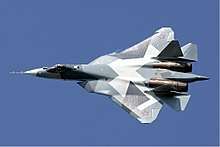 Sukhoi Su-57 (T-50 PAK FA)
Sukhoi Su-57 (T-50 PAK FA) MiG-35
MiG-35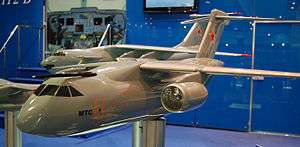 Il-276
Il-276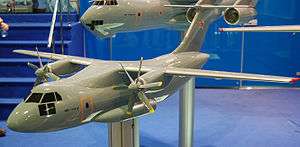 Il-112V
Il-112V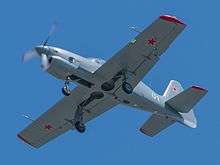 Yak-152
Yak-152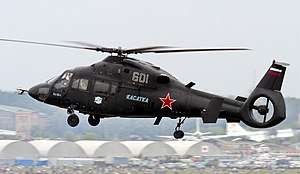 Kamov Ka-60
Kamov Ka-60.jpg) Mi-38
Mi-38
See also
Notes
References
- ↑ https://info.publicintelligence.net/DIA-RussiaMilitaryPower2017.pdf
- ↑ Norwegian Baron (25 July 2016). "Russian Federation (1991-****) Military March "Авиамарш"" – via YouTube.
- ↑ Sizuoka1987 (29 May 2016). "【ロシア軍歌】 航空行進曲 Авиамарш 【歌詞付き】" – via YouTube.
- ↑ La Banda Militare: Italian and International Military Music (22 September 2013). "Авиамарш (Марш Авиаторов) 2" – via YouTube.
- ↑ "US Confirms Russian Airstrikes in Syria", September 2015.
- 1 2 3 Russia creates new Aerospace Force service branch, janes.com, 4 August 2015
- ↑ Austin & Muraviev, The Armed Forces of Russia in Asia, Tauris, 2000, p.235
- ↑ Jeroen Brinkman, 'Russian Air Force in Turmoil,' Air Forces Monthly, No.105, December 1996, p.2, cited in Austin & Muraviev, 2000
- ↑ General Heikki Nikunen, The Current State of the Russian Air Force Archived 15 October 2009 at the Wayback Machine., last updated 2005
- ↑ Piotr Butowski, 'Russia's new air force enters a tight manoeuvre,' Jane's Intelligence Review, May 1999, p.14
- ↑ Piotr Butowski, 'Russia Rising,' Air Forces Monthly, July 2007, p.83
- ↑ Moscow Defense Brief #2, 2010 page 23
- ↑ Routledge/IISS, IISS Military Balance 2007, p.200
- ↑ "BBC NEWS, ',Russia restarts Cold War',, 17 August 2007, patrols". BBC News. 17 August 2007. Retrieved 1 June 2011.
- ↑ Russia restores Soviet-era strategic bomber patrols – Putin −2 Russian News & Information Agency
- ↑ "BBC NEWS, RAF intercepted Russian planes, 30 April 2008". BBC News. 30 April 2008. Retrieved 1 June 2011.
- ↑ Warfare.ru, Air Force: structure accessed May 2009
- ↑ "Russian Military Aircrew Numbers Tumble". Aviationweek.com. 16 December 2009. Retrieved 1 June 2011.
- ↑ Reuters.com, One-third Russian fighter jets old and unsafe: report Friday, 6 February 2009 5:40 am EST
- ↑ "Russian Military Weakness Increases Importance of Strategic Nuclear Forces". Cdi.org. 11 June 2009. Archived from the original on 28 August 2011. Retrieved 1 June 2011.
- ↑ "Russia upgrades bomber-ALCM force for 21st century". Upi.com. 5 January 2009. Retrieved 1 June 2011.
- ↑ "18 September 2009". Asbarez.com. 10 February 1995. Retrieved 1 June 2011.
- ↑ John Pike. "Russian fighter jets make first ever nonstop flight across Russia to Far East". Globalsecurity.org. Retrieved 1 June 2011.
- ↑ "Радиостанция "Эхо Москвы" / Передачи / Военный совет / Суббота, 14.08.2010: Александр Зелин". Echo.msk.ru. Retrieved 1 June 2011.
- ↑ Александр Зелин. "Aviation EXplorer: С-400 начнет защищать границы России в 2012 году". Aex.ru. Retrieved 2012-10-09.
- ↑ ""Максимальный налет летчика в Западном военном округе превысил 215 часов в год " в блоге "Армия и Флот" – Сделано у нас". Сделано у нас. Retrieved 24 December 2014.
- ↑ Gordon, Helene Cooper, Michael R.; Macfarquhar, Neil (30 September 2015). "Russians Strike Targets in Syria, but Not ISIS Areas" – via NYTimes.com.
- ↑ Lydia Tomkiw (24 November 2015). "What Is A Fencer Su-24? What To Know About The Russian Plane Shot Down By Turkey". International Business Times. Retrieved 24 November 2015.
- ↑ Press release (24 November 2015). "Hava sahası İletim" [Transmission of Airspace]. Turkish Armed Forces Chief of Staff (in Turkish). Archived from the original on 24 November 2015. Retrieved 24 November 2015.
- ↑ "Юдин Андрей Вячеславович" [Yudin Andrey Vyacheslavovich] (in Russian). Ministry of Defense of the Russian Federation. Retrieved 19 June 2018.
- ↑ "Russian Armed Forces". baummil.org. Retrieved 1 September 2018.
- ↑ Dmitry Gorenburg, Air Force Structure, 7 February 2011
- ↑ ""Фотофакт. Новые вертолёты Ансат-У и Ка-226 для ВВС России " в блоге "Фотофакты" – Сделано у нас". Сделано у нас. Retrieved 24 December 2014.
- ↑ "Герасимов: Приоритет в 2015 году — развитие стратегических ядерных сил". warfiles.ru. Retrieved 7 March 2016.
- ↑ UKRAINE REPORTS RUSSIAN MILITARY ACTIVITY ON CRIMEA BORDER, Newsweek (8 August 2016)
Gutterman, Steve. "Putin signs Crimea treaty, will not seize other Ukraine regions". Reuters.com. Retrieved 26 March 2014.
Ukraine crisis timeline, BBC News
UN General Assembly adopts resolution affirming Ukraine's territorial integrity, China Central Television (28 March 2014) - ↑ "Запущен второй спутник типа "Лотос-С"". livejournal.com. Retrieved 7 March 2016.
- ↑ "9th independent Anti-Missile Defense Corps". www.ww2.dk.
- ↑ "Major powers: Our Top 10 of military aviation strength". 4 December 2015.
- ↑ "ТАСС: Армия и ОПК – Шойгу: оснащенность Российской армии современным оружием и техникой за год выросла на 7%". ТАСС. Retrieved 3 July 2015.
- ↑ "Восемь МБР приняты на вооружение в интересах РВСН во втором квартале". РИА Новости. Retrieved 7 March 2016.
- ↑ "ЦАМТО / Новости / Выступление министра обороны РФ генерала армии Сергея Шойгу на расширенном заседании Коллегии Минобороны". www.armstrade.org.
- ↑ "Remarks by Chief of General Staff of the Russian Federation General of the Army Valery Gerasimov at the Russian Defence Ministry's board session (November 7, 2017) : Ministry of Defence of the Russian Federation". eng.mil.ru.
- 1 2 International Institute for Strategic Studies: The Military Balance 2014, p.186
- ↑ ""Итоги 2012 года в картинках: ВВС – часть 1 (самолёты)" в блоге "Армия и Флот" – Сделано у нас". Сделано у нас. Retrieved 24 December 2014.
- ↑ ""Итоги 2012 года в картинках: гражданская авиация" в блоге "Авиация" – Сделано у нас". Сделано у нас. Retrieved 24 December 2014.
- ↑ "bmpd". Archived from the original on 10 January 2016. Retrieved 24 December 2014.
- ↑ "bmpd". livejournal.com. Archived from the original on 8 October 2015. Retrieved 1 April 2015.
- ↑ "bmpd". livejournal.com. Archived from the original on 9 September 2015. Retrieved 1 April 2015.
- ↑ "Новые МиГ-29УБ(Р) и МиГ-29СМТ(Р) для ВКС России". livejournal.com. Archived from the original on 1 March 2016. Retrieved 7 March 2016.
- ↑ "Еще четыре Як-130 для ВКС России". livejournal.com. Archived from the original on 5 March 2016. Retrieved 7 March 2016.
- ↑ "«Итоги 2015 года: боевая и учебно-боевая авиация» в блоге «Армия и Флот» – Сделано у нас". Сделано у нас. Retrieved 7 March 2016.
- ↑ "«Итоги 2015 года: гражданская авиация» в блоге «Авиация» – Сделано у нас". Сделано у нас. Retrieved 7 March 2016.
- ↑ bmpd (21 December 2016). "Три последних Як-130 программы 2016 года идут в Армавир".
- ↑ bmpd (16 December 2016). "ВКС России планируют иметь 700 истребителей".
- ↑ bmpd (27 September 2016). "Новый воронежский Ан-148 для Министерства обороны России".
- ↑ bmpd (4 January 2017). "Поставки боевых самолетов в Вооруженные Силы России в 2016 году".
- ↑ "На авиабазу армейской авиации ЗВО в Псковской области поступили 2 новых вертолета Ми-35 : Министерство обороны Российской Федерации". function.mil.ru.
- ↑ "ЦАМТО / Новости / Минобороны имеет твердый контракт на 35 учебно-тренировочных самолетов производства УЗГА". www.armstrade.org.
- ↑ bmpd (5 January 2018). "Поставки боевых самолетов в Вооруженные Силы России в 2017 году".
- ↑ bmpd (1 January 2018). "Шесть новых бомбардировщиков Су-34 построены для перевооружения 2-го бомбардировочного полка".
- ↑ bmpd (26 December 2017). "Министерство обороны России начало закупку самолетов Diamond DA42Т в качестве учебных".
- ↑ "Archived copy". Archived from the original on 16 May 2017. Retrieved 25 October 2017.
- ↑ http://www.vaso.ru/index.php/press/novosti-predpriyatiya/227-1-08-2016-il-96-400-peredan-v-ekspluatatsiyu/
- ↑ "146 вертолетов Ка-52 поступят в войска до 2020 года". Retrieved 5 February 2018.
- ↑ "bmpd.livejournal.com/2961394.html".
- ↑ "Министерство обороны России получило десять новых вертолетов "Ансат-У"". Retrieved 22 December 2017.
- ↑ "bmpd". Archived from the original on 10 January 2016. Retrieved 24 December 2014.
- ↑ ""Итоги 2012 года в картинках: ВВС – часть 2 (вертолёты)" в блоге "Армия и Флот" – Сделано у нас". Сделано у нас. Retrieved 24 December 2014.
- ↑ "bmpd". Archived from the original on 3 July 2014. Retrieved 24 December 2014.
- ↑ "bmpd". Archived from the original on 10 January 2016. Retrieved 24 December 2014.
- ↑ "bmpd". livejournal.com. Archived from the original on 10 January 2016. Retrieved 1 April 2015.
- ↑ "bmpd". livejournal.com. Archived from the original on 5 July 2014. Retrieved 1 April 2015.
- ↑ "bmpd". livejournal.com. Archived from the original on 14 June 2015. Retrieved 3 July 2015.
- ↑ "В 2017 году Минобороны получит 12 боевых вертолетов Ка-52 "Аллигатор"". 7 March 2017.
- ↑ "Вертолеты России" подвели итоги выполнения ГОЗ 2017 года russianhelicopters.aero. 2 February 2018
- ↑ "Продолжение программы вертолета Ка-62". bmpd.livejournal.com. 8 September 2018.
- ↑ "Russia to Build World's Biggest and Fastest Air Freighter". ruaviation.com. Retrieved February 11, 2016.
- ↑ "Контракт на первые шесть истребителей МиГ-35". bmpd.livejournal.com. 23 August 2018.
- ↑ "Russia's MiG aircraft corporation working on fifth-generation fighter jet". TASS. 17 August 2018.
- ↑ "Состоялся первый полет нового вертолета Ми-38 с российскими двигателями ТВ7-117В". Retrieved 24 December 2014.
- ↑ "Контракт еще на два истребителя Су-57 и планы дальнейших закупо". bmpd.livejournal.com. 23 August 2018.
- ↑ "Russia completes work on conceptual design of next-generation strategic bomber". TASS. 22 August 2018.
- ↑ http://www.militarynews.ru/story.asp?rid=0&nid=472105
- ↑ "Испытания учебно-тренировочного самолета Як-152 завершатся в июле". РИА Новости. Retrieved 7 March 2016.
- ↑ "Минобороны заказало 150 легких тренировочных самолетов Як-152". ria.ru. 7 July 2016.
- Bibliography
External links
| Wikimedia Commons has media related to Air force of Russia. |
- Russian Air Force Official site (English)
- Kommersant-Vlast, State of Russia's Air Forces 2008 No.33 (786) 25 August 2008 (in Russian)
- VVS Order of Battle (scramble.nl)
- Photos Russian Air Force
- Russian Military Aviation
- "Russian Revival" – Russia´s technological strategy for post-2010 airpower

